Gujarat Board GSEB Textbook Solutions Class 12 Maths Chapter 8 Application of Integrals Miscellaneous Exercise Textbook Questions and Answers.
Gujarat Board Textbook Solutions Class 12 Maths Chapter 8 Application of Integrals Miscellaneous Exercise
Question 1.
Find the area under the following given curves and given lines:
(i) y = x2, x = 1, x = 2 and x-axis.
(ii) y = x4, x = 1, x = 5 and x-axis.
Solution:
(i) Graphs of parabola y = x2, lines x = 1, x = 2 and x-axis are shown in the figure.
The area of region bounded by y = x2, x = 1, x = 2 and x-axis.
= Area of region PLMQP

(ii) The curve y = x4 passes through (0, 0) and it is symmetric about y-axis for all x ∈ R.
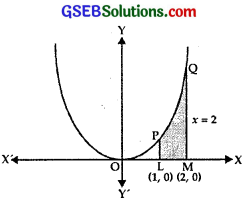
∴ \(\frac{dy}{dx}\) = 4x3.
\(\frac{dy}{dx}\) = 0 at x = 0.
\(\frac{dy}{dx}\) changes sign from – ve to + ve as x increases through x = 0
∴ y is minimum at x = 0.
When x > 0, y is the increasing function.
Graph is as shown in the figure.
Area of region bounded by
y = x4, x = 1,
x = 5 and x-axis
= Area of region ABQPA
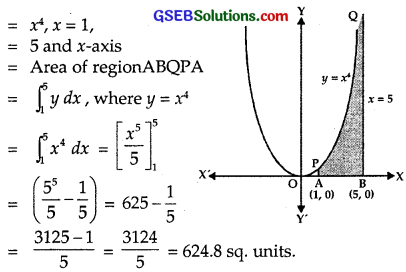
![]()
Question 2.
Find the area between the curves y = x and y = x2.
Solution:
Given curves are
y = x …………… (1)
y = x2 ……………… (2)
Putting y = x in eq.(2), we get
x = x2
∴ x = 0, 1
When x = 1, y = 1
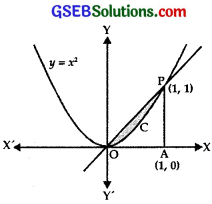
These curves intersect at (0, 0) and (1, 1).
∴ Area between y = x
and y = x2
= Area of the region OCPQ
= Area of OAP – Area of region OAPCO
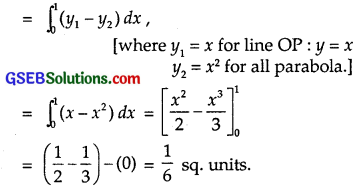
![]()
Question 3.
Find the area of the region lying in first quadrant and bounded by y = 4x2, x = 0, y = 1 and y = 4.
Solution:
The given curve and lines which bound the region are
y = 4x2, x = 0, y = 1 and y = 4.
Graph is as shown in the figure.
The area of the region lying in the first quadrant and bounded by
y = 4x2, x = 0, y = 1 and y = 4

= Area of the region = LPQML
= Area OQMO – Area OPLO

Question 4.
Sketch the graph of y = |x + 3| and evaluate \(\int_{6}^{0}\) |x + 3| dx.
Solution:
y = |x + 3|
At x = – 3, y = 0
AQ is the line y = x + 3.
When x + 3 < 0,
y = -(x + 3)
= – x – 3

Graph of the line is AP.
∴ Graph of y = |x + 3| is as shown in the figure.

![]()
Question 5.
Find the area bounded by the curve y = sin x between x = 0 and x = 2π.
Solution:
Some points on the sine graph are:

Plotting these points, we get the graph OPAQB.
Since sin(2π – x) = – sin x, therefore
graph between x = π and x = 2π has the same shape but it is below the x-axis.
Area of the region OPA = Area of the region AQB.
∴ Area bounded by the curve y = sin x between x = 0 and x = 2π.
= 2 × Area of the region OPA

= – 2[cos π – cos 0] = 2[1 + 1] = 4.
Question 6.
Find the area enclosed between the parabola y2 = 4ax and the line y = mx.
Solution:
The given curves are
y = mx …………….. (1)
y2 = 4ax …………….. (2)
Putting value of y from (1) in (2), we get
m2x2 = 4ax
or x(m2x – 4a) = 0
∴ x = 0, x = \(\frac{4 a}{m^{2}}\).
Putting x = \(\frac{4 a}{m^{2}}\) in (1),
y = m.\(\frac{4 a}{m^{2}}\) = \(\frac{4a}{m}\)
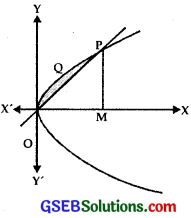
∴ The curve y2 = 4ax and OP intersect at O(0, 0) and
∴ Area enclosed between the parabola y2 = 4ax and the line y = mx.
= Area of the region OPOQ [As per figure]
= Area of the region OMPQO – Area of ∆ OMP

![]()
Question 7.
Find the area enclosed by the parabola 4y = 3x2 and the line 2y = 3x + 12.
Solution:
The parabola and the line are
4y = 3x2 …………………. (1)
2y = 3sx + 12 ………………. (2)
Multiplying (2) by 2 and
Subtracting from (1), we get
0 = 3x2 – 6x – 24
or x2 – 2x – 8 = 0
or (x – 4)(x + 2) = 0
∴ x = 4, – 2
From (2), y = 12, 3

The graph of parabola and lines are shown in the figure. They intersect at P(- 2, 3) and Q(4, 12).
∴ The area enclosed by the parabola 4y = 3x2
and the line 2y = 3x + 12
= Area of the region POPQP
= Area of trapezium PLMQP – Area of the region LMQROP
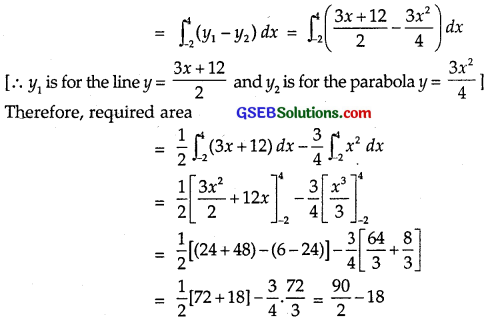
= 45 – 18 = 27 sq.units.
Question 8.
Find the area of the smaller region bounded by the ellipse
\(\frac{x^{2}}{9}\) + \(\frac{y^{2}}{4}\) = 1 and the straight line \(\frac{x}{3}\) + \(\frac{y}{2}\) = 1.
Solution:
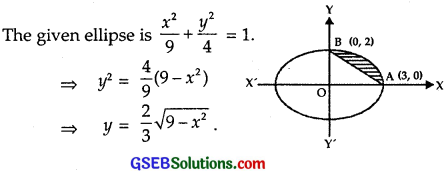
It is an ellipse with vertices at A(3, 0) and B(0, 2) and length of the major axis = 2(3) = 6 and length of the minor axis 2(2) = 4.
Line \(\frac{x}{3}\) + \(\frac{y}{2}\) = 1 ⇒ y = (\(\frac{6-2x}{3}\))
It is a straight line passing through A(3, 0) and B(0, 2).
Smaller area common to both is shaded.

For I1 put x = 3 sin θ so that dx = 3 cos θ dθ.
When x = 0, θ = 0 and when x = 3, θ = \(\frac{π}{2}\)

![]()
Question 9.
Find the area of the smaller region bounded by the ellipse
\(\frac{x^{2}}{a^{2}}\) + \(\frac{y^{2}}{b^{2}}\) = 1 and the staraight line \(\frac{x}{a}\) + \(\frac{y}{b}\) = 1.
Solution:

Question 10.
Find the area of the region enclosed by parabola x2 = y, the line y = x + 2 and the x-axis.
Solution:
We have x2 = y. It represents a parabola with vertex at (0, 0), axis along the positive direction of y-axis and it opens upwards.
Also, y = x + 2 represents a straight line cutting x-axis at (-2, 0).
Solving x2 = y and y = x + 2, we get
x2 = x + 2
⇒ x2 – x – 2 = 0
⇒ (x – 2)(x + 1) = 0
⇒ x = 2, x = 1.
⇒ When x = 2, y = (2)2 = 4
and when x = – 1, y = (- 1)2 = 1.
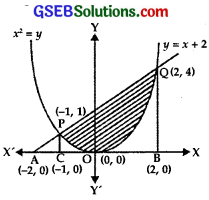
So the two curves x2 = y and y = x + 2 intersect at the points (2, 4) and (- 1, 1).
Required area = Shaded region shown in the figure
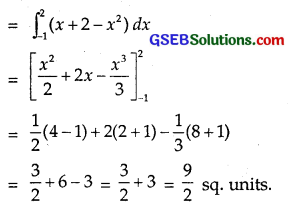
![]()
Question 11.
Using method of integration, find the area bounded by |x| + |y| = 1.
Solution:
In I Quadrant, x > 0 and y > 0.
⇒ |x| = x, |y| = y.
The line is x + y = 1 …………….. (1)
In II Quadrant, x < 0 and y > 0.
⇒ |x| = – x. |y| = y.
The line is – x + y = 1
or x – y = -1 ………………… (2)
In III Quadrant, x < 0 and y < 0. ⇒ |x| = – x, |y| = – y. The line is – x – y = 1 or x + y = -1 ………….. (3)
In IV Quadrant, x > 0 and y < 0.
⇒ |x| = x, |y| = – y,
The line is x – y = 1 …………. (4)
Thus, |x| + |y| = 1 represent four lines forming a square ABCD.
Area of square ABCD
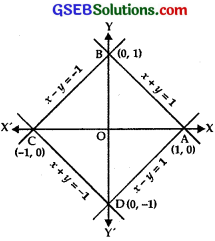
= 4 × Area of ∆ AOB
= 4 × \(\int_{0}^{1}\) (1 – x) dx
Since x + y = 1 is the equation of the line AB.

= 4 × \(\frac{1}{2}\) = 2 sq.units.
Question 12.
Find the area bounded by the curves {(x, y) y = ≥ x2 and y = |x|}.
Solution:
Clearly, x2 = y represents parabola with vertex at (0, 0), positive direction of y-axis as its axis and it opens upwards.
y= | x |, i.e., y = x and y = – x represent two lines passing through the origin and making an angle of 45° and 135° with the positive direction of the x-axis.
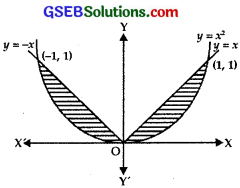
The required region is the shaded region as shown in the figure. Since both the curves are symmetrical about y-axis, therefore
required area = 2(shaded area in the first quadrant)

![]()
Question 13.
Using the method of integration, find the area of the triangle ABC, coordinates of whose vertices are A(2, 0), B(4, 5) and C(6, 3).
Solution:
Equation of the line AB is
y – 0 = \(\frac{5-0}{4-2}\)(x – 2)
⇒ y = \(\frac{5}{2}\)(x – 2).
Equation of the line BC is
y – 5 = \(\frac{3-5}{6-4}\)(x – 4)
⇒ y = – x + 9.
Equation of the line CA is
y – 3 = \(\frac{0-3}{2-6}\)(x – 6)
⇒ y = \(\frac{3}{4}\)(x – 2).

Required area = area of the region bounded by ∆ ABC
= area of the region AMB + area of the region BMNC – area of the region ANC

= 5 + 8 – 6 = 7 sq. units.
Question 14.
Using the method of integration, find the area of the region bounded by the lines
2x + y = 4, 3x – 2y = 6 and x – 3y + 5 = 0.
Solution:
The given lines are 2x + y = 4 ………….. (1)
3x – 2y = 6 ……………….. (2)
x – 3y = – 5 ……………….. (3)
Multiplying (3) by 2 and subtracting from (1), we get
7y = 14 ⇒ y = 2.
So, from (3) x – 6 = 5 ⇒ x = 1.
∴ Lines (1) and (3) intersect at (1, 2).
Again multiplying (3) by 3 and subtract it from (2). We get
7y = 21 ∴ y – 3.
From (3), X – 9 = – 5 ⇒ x = 4.
∴ Lines (2) and (3) intersect at (4, 3).
Multiply eq. (1) by 2 and add it to (2).
We get: 7x = 14 ∴ x = 2
From (2), 4 + y – 4 ∴ y = 0.
Lines (1) and (2) intersect at (2, 0).
The points A(1, 2), B(4, 3) and C(2, 3) are plotted and joined obtaining triangle ABC.
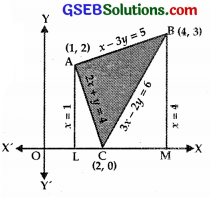
Area of ∆ ABC = Area of trapezium ALMB – Area of ∆ ALC – Area of ∆ BCM

![]()
Question 15.
Find the area of the region {(x, y) : y2 ≤ 4x, 4x2 + 4y2 ≤ 9}.
Solution:
y2 = 4x is a parabola whose vertex is the origin and 4x2 + 4y2 = 9
represents a circle whose centre is (0, 0) and radius = \(\frac{3}{2}\).
On solving y2 = 4x
and x2 + y2 = \(\frac{9}{4}\).
The points of intersection are P(\(\frac{1}{2}\), \(\sqrt{2}\)) and Q(\(\frac{1}{2}\), – \(\sqrt{2}\)).
Both the curves are symmetrical about x-axis

Required area = area of the shaded region
= 2(area of the region OAPO)
= 2[(area of the region OMPO) + (area of the region MAPM)]

Choose the correct answers in the following questions 16 to 19:
Question 16.
The area bounded by the curve y = x3, the x-axis and ordinates x = – 2 and x = 1 is
(A) – 9
(B) – \(\frac{15}{4}\)
(C) \(\frac{15}{4}\)
(D) \(\frac{17}{4}\)
Solution:
The curve is y = x3.
Differentiating, we get
\(\frac{dy}{dx}\) = 3x2 = +ve
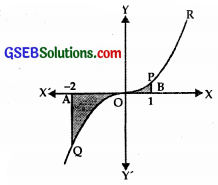
∴ Curve is an increasing curve.
\(\frac{dy}{dx}\) = 0 ⇒ x = 0.
∴ x-axis is the tangent at x = 0.
f(- x) = – f(x) ∴ (- x)3 = – x3.
Curve is symmetrical in opposite quadrants,
Area bounded by the curve y = x3, the x-axis, x = – 2 and x = 1
= Area of the region AQOBPOA
= Area of the region AQOA + Area of the region ∆ BPO

∴ Part D is the correct answer.
![]()
Question 17.
The area bounded by the curve y = x |x|, x-axis and the ordinates x = – 1 and x = 1 given by
(A) 0
(B) \(\frac{1}{3}\)
(C) \(\frac{2}{3}\)
(D) \(\frac{4}{3}\)
Solution:
When x > 0, |x| = x.
∴ The equation of the curve is y = x2.
When x < 0, |x| = – x.
∴ Equation of the curve is
y = x2.
∴ Area bounded by the curve
y = x|x|,
x-axis and ordinates x = – 1, x = 1
= Area of region + Area of region ∆ BQO
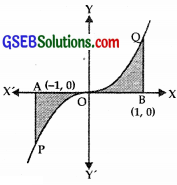
= 2 × Area of region ∆ BQO
(∵ These areas are equal due to symmetry)

∴ Part (C) is the correct answer.
Question 18.
The area of the circle x2 + y2 = 16 exterior to the parabola y2 = 6x is
(A) \(\frac{4}{3}\) (4π – \(\sqrt{3}\))
(B) \(\frac{4}{3}\) (4π + \(\sqrt{3}\))
(C) \(\frac{4}{3}\) (8π – \(\sqrt{3}\))
(D) \(\frac{4}{3}\) (8π + \(\sqrt{3}\))
Solution:
The given curves are
x2 + y2 = 16 ………….. (1)
y2 = 6x ……………….. (2)
Putting y2 = 6x in (1), we get
x2 + 6x = 16
or x2 + 6x – 16 = 0
(x + 8)(x – 2) = 0
∴ x = – 8, 2
But x ≠ – 8
So, x = 2.
From (2), y2 = 6x ⇒ y = ± 2\(\sqrt{3}\)

Area of the whole circle
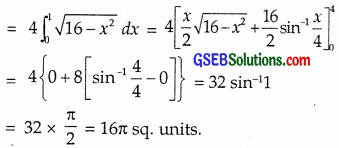
Now circle and parabola intersect at P(2, 2\(\sqrt{3}\)) and Q (2, – 2\(\sqrt{3}\)).
Smaller area enclosed by circle and parabola
= Area of region OQAP
= 2 × Area of region OQAP
= 2 × [Area of region OMP + Area of region MAP]
= 2(\(\int_{0}^{2} y_{1} d x+\int_{2}^{4} y_{2} d x\))
When y1 is for parabola y2 = 6x. ∴ y = \(\sqrt{6x}\).
y2 is for circle x2 + y2 = 16 ∴ y = \(\sqrt{16-x^{2}}\)

Common area exterior to the parabola y2 = 6x is equal to
16π – (\(\frac{4 \sqrt{3}}{3}\) + \(\frac{16}{3}\)π)
= \(\frac{32}{3}\)π – \(\frac{4 \sqrt{3}}{3}\) = \(\frac{4}{3}\)(8π – \(\sqrt{3}\)).
∴ Part (C) is the correct answer.
![]()
Question 19.
The area bounded by y-axis, y = cos x and y = sin x, 0 ≤ x ≤ \(\frac{π}{2}\) is
(A) 2(\(\sqrt{2}\) – 1)
(B) \(\sqrt{2}\) – 1
(C) \(\sqrt{2}\) + 1
(D) \(\sqrt{2}\)
Solution:
The curve are y = cos x, y = sin x, 0 ≤ x ≤ \(\frac{π}{2}\).
The curve meet
where sin x = cos x.
or tan x = 1
⇒ x = \(\frac{π}{4}\).
sin \(\frac{π}{4}\) = cos \(\frac{π}{4}\) = \(\frac{1}{\sqrt{2}}\).

Graphs of these curves are as shown in the figure.
They intersect at P(\(\frac{π}{4}\), \(\frac{1}{\sqrt{2}}\)).
The area bounded by y-axis, y = cos x and y = sin x (0 ≤ x ≤ \(\frac{π}{2}\))
= shaded area
= Area of region ∆ OPBO
= Area of region ∆ PAO + Area of region ∆ PBA

where x1 is for y = sin x or x = sin-1y ,
and x2 is for y = cos x or x = cos-1 y.

∴ Part (B) is the correct answer.